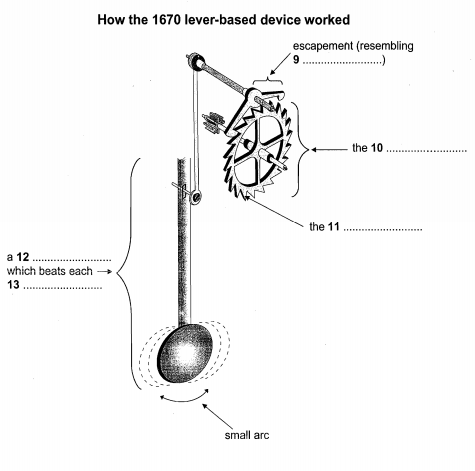剑桥雅思8阅读:Test1雅思阅读PASSAGE 1真题+答案+解析
发布时间:2020-11-19 关键词:READING
READING PASSAGE 1
You should spend about 20 minutes on Questions 1-13, which are based on ReadingPassage 1 below,
A Chronicle ofTimekeeping
Our conception of time depends on the way we measure it
A According to archaeological evidence, at least 5,000 years ago, and long before the adventof the Roman Empire, the Babylonians began to measure time, introducing calendarsto co-ordinate communal activities, to plan the shipment of goods and, in particular, tonegulate planting and harvesting They based their calendars on three natural cycles: thesolar day, marked by the uccessive periods of light and darkness as the earth rotates onits axis; the lunar month, fllowing the phases of the moon as it orbits the earth; andthe solar year, defined by the changing seasons that accompany our planet's revolutionaround the sun.
B Before the invention of arificiali light, the moon had greater social impact. And, for thoseliving near the equator in particular, its waxing and waning was more conspicuous thanthe passing o the seasons. Hence, the calendars that were developed at the lower latitudeswere influenced more by the lunar cycle than by the solar year. In more northern dimes,however, where seasonal agriculture was practised, the solar year became more crucial. Asthe Roman Empire expanded northward, it organised its activity chart for the most partaround the solar year.
C Centuries before the Roman Empire, the Egyptians had formulated a municipal calendarhaving 12 months of 30 days, with five days added to approximate the solar year. Eachperiod of ten days was marked by the appearance of special groups of stars alled decans.At the rise of the star Sirius just before sunrise, which occurred around the al-importantannual fooding of the Nile, 12 decans could be seen spanning the heavens. The cosmicsignificance the Egyptians placed in the 12 decans led them to develop a system in whichcach interval of darkness (and later, each interval of daylight) was divided into a dozenequal parts. These periods became known as temporal hours because their duration variedaccording to the changing length of days and nights with the passing of the seasons.
Summer hours were long, winter ones short; only at the spring and autumn equinoxes
were the hours of daylight and darknens equal. Temporal hours, which were first adoptedby the Greeks and then the Romans, who dsseminated them through Europe, remainedin use for more than 2,500 years.
D In order to track temporal hours during the day, inventors created sundials, which indicatetime by the length or direction of the sun's shadow. The sundial's counterpart, the waterdock, was designed to measure temporal hours at night. One of the first water docks
was a basin with a small hole near the bottom through which the water dripped out. Theflling water level denoted the passing hour as it dipped below hour lines inscribed on theinner surface. Although these devices performed satisfactorily around the Mediterranean,they could not always be depended on in the cloudy and often freezing weather of
northern Europe.
E The advent of the mechanical clock meant that although it could be adjusted to maintaintemporal hour, it was naturally suited to keeping equal ones. With these, however, arosethe question of when to begin counting and s0, in the early 14th century, a number ofsystems evolved. The schemes that divided the day into 24 equal parts varied accordingto the start of the count: Italian hours began at sunset, Babylonian hours at sunrise,astronomical hours at midday and 'great dock' hours, used for some large public clocksin Germany, at midnight. Eventually these were superseded by 'small dock', or French,hours, which split the day into two 12-hour periods commencing at midnight.
F The earliest recorded weight driven mechanical dock was built in 1283 in Bedfordshirein England. The revolutionary aspect of this new timekeeper was neither the descendingweight that provided its motive force nor the gear wheels (which had been around for atleast 1,300 years) that transferred the power; it was the part alled the esapement. In theearly 1400s came the invention of the coiled spring or fusee which maintained constantforce to the gear wheels of the timekeper despite the changing tension of its mainspring.By the 16th century, a pendulum clock had been devised, but the pendulum swung in alarge arc and thus was not very efcient.
G To address this, a variation on the original esapement was invented in 1670, in England.It was alld the anchor escapement, which was a lever based device shaped like a ship'sanchor.' The morion of a pendulum rocks this device so that it catches and then releaseseach tooth of the escape wheel, in turn allowing it to turn a predise amount. Unlike
the original form used in early pendulum docks, the anchor esapement permitted thependulum to travel in a very small arc. Moreover, this invention allowed the use ofa longpendulum which could beat once a second and thus led to the development of a new floor-standing case design, which became known as the grandfather clock.
H Today, highly accurate timekeping instruments set the beat for most electronic devices.Nearly all computers contain a quartz-crystal clock to regulate their operation. Moreover,not only do time signals beamed down from Global Positioning System stllites calibratethe functions of precision navigation equipment, they do so as well for mobile phones,instant stock-urading systems and nationwide power-distribution grids. So integral havethese time-based technologies become to day-to-day existence that our dependency onthem is recognised only when they fail to work.
阅读
阅读通道 1
你应该花大约 20 分钟在问题 1 - 13, 这是基于阅读通 1 下面,守纪事纪事,我们对时间的概念取决于我们衡量它的方式
A 根据考古证据,至少5000年前,早在罗马帝国出现之前,巴比伦人就开始测量时间,引入日历来协调社区活动,计划货物的运输,特别是根据三个自然周期来调整种植和收获的日历。太阳日,以地球在轴线上旋转时光和黑暗的光和黑暗时期为标志;农历月,在绕地球运行时,在月球的阶段中飞向一个;和太阳年,由伴随我们星球围绕太阳的革命而变化的季节所定义。
B 在发明利菲利光之前,月球具有更大的社会影响。而且,对于那些生活在赤道附近的人,它的打蜡和消退比季节的流逝更引人注目。因此,在低纬度地区开发的日历受月球周期的影响大于受太阳年的影响。然而,在北方的一毛钱,季节性农业实行,太阳年变得更加关键。随着罗马帝国向北扩张,它组织了大部分围绕太阳年的活动图。
在罗马帝国前的几个世纪里,埃及人制定了一个为期12个月的30天的市政日历,加上5天来接近太阳年。每十天,都出现了一群特殊的星星。日出前,在尼罗河重要年吃一次的恒星天狼星升起时,可以看到12个十二颗十分的十二颗星横跨天空。埃及人放在12个十二分的宇宙上,导致他们发展了一个系统,其中黑暗间隔(后来,日光的每个间隔)被分成十几个等值部分。这些时期被称为时态,因为它们的持续时间随季节的流逝而变化的日日夜夜变化而变化。
夏天时间长,冬天短;只在春秋两分
是白天和黑暗的时间相等。时间,这是首先由希腊人,然后罗马人,谁通过欧洲,保持使用超过2,500年。
D 为了跟踪白天的时间,发明者创造了日光,通过太阳阴影的长度或方向来指示时间。太阳的对应物,水坞,被设计用来测量夜间的时间。首批水码头之一 是一个盆地,底部附近有一个小洞,水通过它滴出来。水位下降表示过去一小时,因为它下降到低于刻在内层表面的小时线。虽然这些设备在地中海周围表现令人满意,但它们不能总是依靠在多云和经常是寒冷的天气北欧。
E 机械时钟的出现意味着,虽然它可以调整为保持时空小时,但它自然适合保持相等的时间。然而,随着这些问题的出现,人们开始计算和s0的问题,在14世纪早期,许多系统进化而来。将当天分为24个等分的方案根据计数的开始而有所不同:意大利时间从日落开始,巴比伦时间从日出开始,天文时间在中午,"大码头"时间,用于德国的一些大型公共时钟,午夜。最终,这些被"小码头"(或法语)取代,从午夜开始,将一天分成两个12小时。
F 最早记录的重量驱动机械码头建于1283年,在英国贝德福德郡。这个新计时器的革命性方面既不是提供动力的降重量,也不是转移动力的齿轮(至少已经存在了1,300年);这是部分所有在 esapement 。在1400年代,出现了盘绕弹簧或计划丝的发明,尽管其主弹簧的张力不断变化,却保持了对时间保持器齿轮的恒定力。到16世纪,钟摆钟已经设计出来,但钟摆在一个大弧形中摆动,因此不是很兴奋。
为了解决这个问题,1670年发明了一种对原始船的变种,England.It年,锚逸,这是一个基于杠杆的装置,形状像船的"三分之一"。钟摆的停尸石会摇动这个装置,使其捕获并释放逃生轮的每颗牙齿,进而允许它转动预制量。与
早期钟摆码头使用的原始形式,锚点允许钟摆在小的弧线中行驶。此外,本发明允许使用长公,可以击败一秒一次,从而导致一个新的地板立案设计的发展,这被称为祖父时钟。
今天,高精度的定时仪器为大多数电子设备设置了节拍。几乎所有的计算机都包含一个石英晶体时钟来调节其操作。此外,全球定位系统信号传递下来,不仅校准了精密导航设备的功能,而且为移动电话、即时库存系统、全国配电电网等功能。因此,这些基于时间的技术成为日常存在的不可或缺的,因此,只有当它们不能工作时,我们才认识到对它们的依赖。
是白天和黑暗的时间相等。时间,这是首先由希腊人,然后罗马人,谁通过欧洲,保持使用超过2,500年。
D 为了跟踪白天的时间,发明者创造了日光,通过太阳阴影的长度或方向来指示时间。太阳的对应物,水坞,被设计用来测量夜间的时间。首批水码头之一
是一个盆地,底部附近有一个小洞,水通过它滴出来。水位下降表示过去一小时,因为它下降到低于刻在内层表面的小时线。虽然这些设备在地中海周围表现令人满意,但它们不能总是依靠在多云和经常是寒冷的天气
北欧。
E 机械时钟的出现意味着,虽然它可以调整为保持时空小时,但它自然适合保持相等的时间。然而,随着这些问题的出现,人们开始计算和s0的问题,在14世纪早期,许多系统进化而来。将当天分为24个等分的方案根据计数的开始而有所不同:意大利时间从日落开始,巴比伦时间从日出开始,天文时间在中午,"大码头"时间,用于德国的一些大型公共时钟,午夜。最终,这些被"小码头"(或法语)取代,从午夜开始,将一天分成两个12小时。
F 最早记录的重量驱动机械码头建于1283年,在英国贝德福德郡。这个新计时器的革命性方面既不是提供动力的降重量,也不是转移动力的齿轮(至少已经存在了1,300年);这是部分所有在 esapement 。在1400年代,出现了盘绕弹簧或计划丝的发明,尽管其主弹簧的张力不断变化,却保持了对时间保持器齿轮的恒定力。到16世纪,钟摆钟已经设计出来,但钟摆在一个大弧形中摆动,因此不是很兴奋。
为了解决这个问题,1670年发明了一种对原始船的变种,England.It年,锚逸,这是一个基于杠杆的装置,形状像船的"三分之一"。钟摆的停尸石会摇动这个装置,使其捕获并释放逃生轮的每颗牙齿,进而允许它转动预制量。与
早期钟摆码头使用的原始形式,锚点允许钟摆在小的弧线中行驶。此外,本发明允许使用长公,可以击败一秒一次,从而导致一个新的地板立案设计的发展,这被称为祖父时钟。
今天,高精度的定时仪器为大多数电子设备设置了节拍。几乎所有的计算机都包含一个石英晶体时钟来调节其操作。此外,全球定位系统信号传递下来,不仅校准了精密导航设备的功能,而且为移动电话、即时库存系统、全国配电电网等功能。因此,这些基于时间的技术成为日常存在的不可或缺的,因此,只有当它们不能工作时,我们才认识到对它们的依赖。
were the hours of daylight and darknens equal. Temporal hours, which were first adoptedby the Greeks and then the Romans, who dsseminated them through Europe, remainedin use for more than 2,500 years.
D In order to track temporal hours during the day, inventors created sundials, which indicatetime by the length or direction of the sun's shadow. The sundial's counterpart, the waterdock, was designed to measure temporal hours at night. One of the first water docks
was a basin with a small hole near the bottom through which the water dripped out. Theflling water level denoted the passing hour as it dipped below hour lines inscribed on theinner surface. Although these devices performed satisfactorily around the Mediterranean,they could not always be depended on in the cloudy and often freezing weather of northern Europe.
E The advent of the mechanical clock meant that although it could be adjusted to maintaintemporal hour, it was naturally suited to keeping equal ones. With these, however, arosethe question of when to begin counting and s0, in the early 14th century, a number ofsystems evolved. The schemes that divided the day into 24 equal parts varied accordingto the start of the count: Italian hours began at sunset, Babylonian hours at sunrise,astronomical hours at midday and 'great dock' hours, used for some large public clocksin Germany, at midnight. Eventually these were superseded by 'small dock', or French,hours, which split the day into two 12-hour periods commencing at midnight.
F The earliest recorded weight driven mechanical dock was built in 1283 in Bedfordshirein England. The revolutionary aspect of this new timekeeper was neither the descendingweight that provided its motive force nor the gear wheels (which had been around for atleast 1,300 years) that transferred the power; it was the part alled the esapement. In theearly 1400s came the invention of the coiled spring or fusee which maintained constantforce to the gear wheels of the timekeper despite the changing tension of its mainspring.By the 16th century, a pendulum clock had been devised, but the pendulum swung in alarge arc and thus was not very efcient.
G To address this, a variation on the original esapement was invented in 1670, in England.It was alld the anchor escapement, which was a lever based device shaped like a ship'sanchor.' The morion of a pendulum rocks this device so that it catches and then releaseseach tooth of the escape wheel, in turn allowing it to turn a predise amount. Unlike the original form used in early pendulum docks, the anchor esapement permitted thependulum to travel in a very small arc. Moreover, this invention allowed the use ofa longpendulum which could beat once a second and thus led to the development of a new floor-standing case design, which became known as the grandfather clock.
H Today, highly accurate timekeping instruments set the beat for most electronic devices.Nearly all computers contain a quartz-crystal clock to regulate their operation. Moreover,not only do time signals beamed down from Global Positioning System stllites calibratethe functions of precision navigation equipment, they do so as well for mobile phones,instant stock-urading systems and nationwide power-distribution grids. So integral havethese time-based technologies become to day-to-day existence that our dependency onthem is recognised only when they fail to work.
Questions 1-4
Reading Passage 1 has eight paragraphs, A-H.Which paragraph contains the following information?
Write the correct ltter, A- H, in boxes 1-4 on your answer sheet.
1 a description of an early timekeeping invention affected by cold temperatures
2 an explanation of the importance of geography in the development of the calendarin farming communities
3 a description of the origins of the pendulum clock
4 details of the simultaneous efforts of dfferent societies to calculate time usinguniform hours
Questions 58
Look at the folloning events (Questions 5 -8) and the list ol nationalities below.Match each event with the correct nationality, A-F.
Write the correct lettr A-F, in boxes 5 -8 on your answer sheet.
5 They devised a civil calendar in which the months were equal in length.
6 They divided the day into two equal halves.
7 They developed a new cabinet shape for a type of timekeeper.8
8 They created a calendar to organise public events and work schedules.
9 List of Nationalities
A Babylonians
B Egyptians
C Greeks
English
Germans
F French
问题1-4
阅读文章1有八个段落,A-H。哪一段包含了以下信息?
在答题纸上的1-4栏中写下正确的答案。
1一个早期计时发明受低温影响的描述
2阐述地理在金盏花农业群落发展中的重要性
3钟摆的起源的描述
4不同社会同时使用统一时间计算时间的细节
问题5--8
请看下面的事件(问题5-8)和下列的名单。匹配每个事件与正确的国籍,A-F。
在答题纸上的第5-8个方框中写出正确的字母A-F。
5 他们发明了一种民间历法,其中每个月长度相等
6他们把一天分成相等的两半。
7他们为一种计时器开发了一种新的橱柜形状
他们创建了一个日历来组织公共活动和工作时间表。
A巴比伦人
B埃及人
C希腊
D英语
E德语
F法语
Questions 9- -13
Label the diagram below.
Choose NO MORE THAN TWO WORDS from the passage for each answer,Write your answers in boxes g- -13 on your answer sheet.
How the 1670 lever-based device worked
问题9--13
将下面的图标上标签。
选择没有每个答案中的两个单词,把你的答案写在方框里。G-13在你的答题纸上。
1670杠杆式设备是如何工作的

答案:





